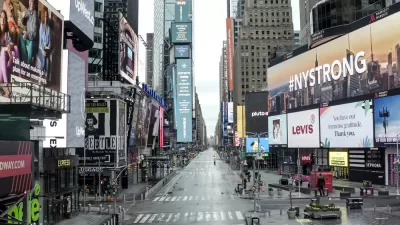Data from millions of cellphone customers will be used to locate and alert individuals who may have come into contact with people carrying the virus.

"Prime Minister Benjamin Netanyahu of Israel has authorized the country’s internal security agency to tap into a vast and previously undisclosed trove of cellphone data to retrace the movements of people who have contracted the coronavirus and identify others who should be quarantined because their paths crossed," report David M. Halbfinger, Isabel Kershner, and Ronen Bergman.
The plan is to use geolocation data from cellphones to identify people who may have been exposed to the virus and send text messages telling them to isolate themselves. The data is regularly collected for counterterrorism purposes, but using it for public health efforts is new.
Halbfinger, Kershner, and Bergman go into more detail about the political situation in Israel and the debate around privacy concerns. "It is the existence of the cellphone metadata trove and its use to track coronavirus patients and carriers that privacy advocates say poses the greatest test of Israeli democracy at an extraordinarily fragile moment," they say.
[Update: new reports reveal that cellphone companies in numerous countries around the world are sharing data with health officials. See articles published by the The Verge and Reuters for more.]
FULL STORY: To Track Coronavirus, Israel Moves to Tap Secret Trove of Cellphone Data

Alabama: Trump Terminates Settlements for Black Communities Harmed By Raw Sewage
Trump deemed the landmark civil rights agreement “illegal DEI and environmental justice policy.”

Planetizen Federal Action Tracker
A weekly monitor of how Trump’s orders and actions are impacting planners and planning in America.

The 120 Year Old Tiny Home Villages That Sheltered San Francisco’s Earthquake Refugees
More than a century ago, San Francisco mobilized to house thousands of residents displaced by the 1906 earthquake. Could their strategy offer a model for the present?

LA’s Tree Emergency Goes Beyond Vandalism
After a vandal destroyed dozens of downtown LA trees, Mayor Karen Bass vowed to replace them. Days later, she slashed the city’s tree budget.

Sacramento Leads Nation With Bus-Mounted Bike Lane Enforcement Cameras
The city is the first to use its bus-mounted traffic enforcement system to cite drivers who park or drive in bike lanes.

Seattle Voters Approve Social Housing Referendum
Voters approved a corporate tax to fund the city’s housing authority despite an opposition campaign funded by Amazon and Microsoft.
Urban Design for Planners 1: Software Tools
This six-course series explores essential urban design concepts using open source software and equips planners with the tools they need to participate fully in the urban design process.
Planning for Universal Design
Learn the tools for implementing Universal Design in planning regulations.
Ada County Highway District
Clanton & Associates, Inc.
Jessamine County Fiscal Court
Institute for Housing and Urban Development Studies (IHS)
City of Grandview
Harvard GSD Executive Education
Toledo-Lucas County Plan Commissions
Salt Lake City
NYU Wagner Graduate School of Public Service





























